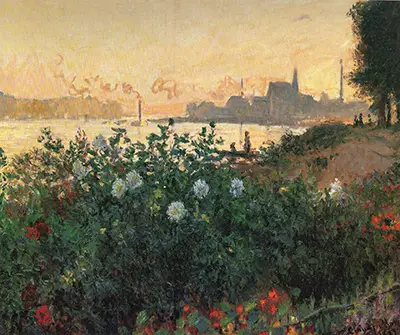It is one of the many works done by this artist while contemplating the Seine River, and it’s widely regarded as one of the most meticulous impressionist works.
Painting Techniques in Riverbank at Argenteuil
This beautiful and intriguing landscape was made using the oil on canvas technique, which was at the time starting to flourish with the advent of premixed paints being sold in tubes.
Oil over canvas was the material of choice of of many impressionistic painters, for its spontaneous looking effects and ample versatility which make it a good choice for both indoors and outdoors paintings.
It was common for impressionists to begin their work outdoors and finish it indoors, and that was exactly how this piece was produced.
The canvas Manet used to paint this work measures 62.3 cm tall and 103 cm wide. It has been mounted on a frame measuring 87 cm tall and 126 cm wide, with a depth of 10 cm. The original canvas was signed “Manet ‘74” at the bottom left corner as well as in the back.
Many experts regard Riverbank at Argenteuil as one of the most notable exploratory works ever made by an impressionist in a plein-air (open air) setting.
True to Manet's role as a precursor of impressionistic painting, this landscape bridges the gap between the meticulous approach of classical realism and the loose and fluid style that would be fully embraced by impressionist painters.
The History Behind the Riverbank at Argenteuil Painting
This work was painted by Manet in the Summer of 1874 during one of his visits to his friend Monet and family, who at the time lived in Argenteuil, then a fast growing little town located right outside of Paris.
Monet's wife (Camille) and their son (Jean) were actually the models for the figures in the scene’s foreground, taking up the left side of the painting.
This is an important work art history, since it shows Manet’s exploration of new ways to depict the warm summer sunlight and vivid reflections on the water by using energetic strokes that feel as tough they were painted in a delightful and sunny artistic frenzy.
Understanding the Theme of This Painting
To understand the theme of Riberbank at Argenteuil, one has to consider the motivation of impressionistic painters – these artists were above all interested in painting outdoors, while looking to capture the wondrous colors of nature directly from the source, and emphasize them for everyone to see.
This explains the sense of urgency and fluidity in these paintings, as they were often made in a race against time before the daylight shifted and faded.
The uniquely fleeting atmosphere created by the interplay between light and water is the central theme of this landscape, with the figures standing on the riverbank suggesting a moment of contemplation and introspection.
It feels as though Manet is trying to make us see the extraordinary beauty of something as apparently trivial as the boats coursing through the Seine river.
Through this painting, Manet urges the viewer to look intently at the glorious display of natural wonder available to those who pay close attention to the subtle changes in the surrounding atmosphere.
All objects and figures in the painting are secondary to the mood conveyed by the painting as a whole.



